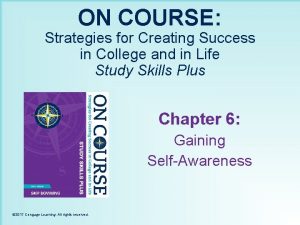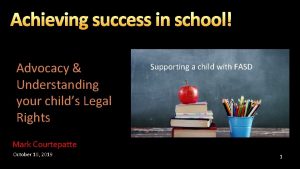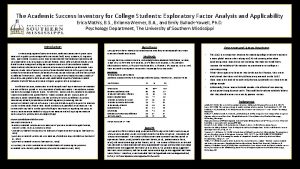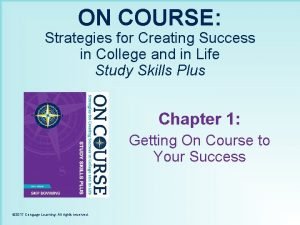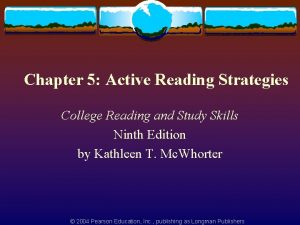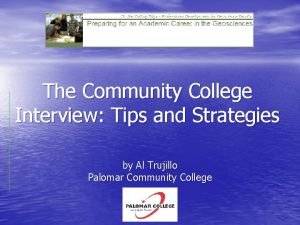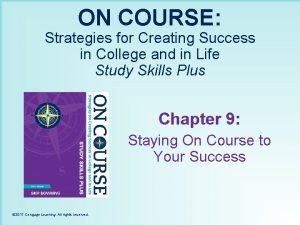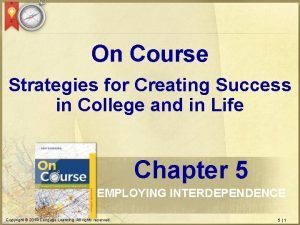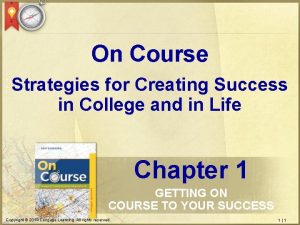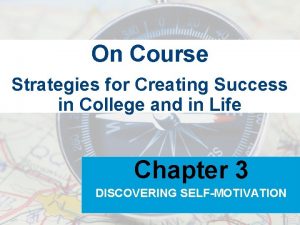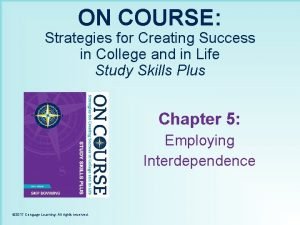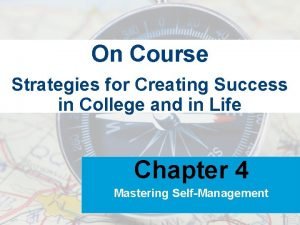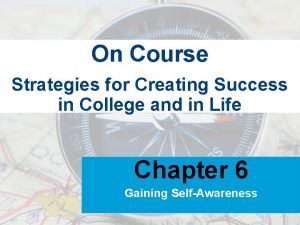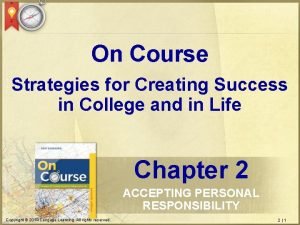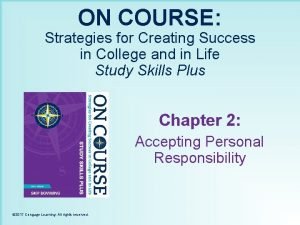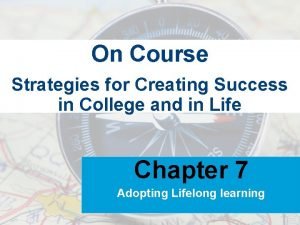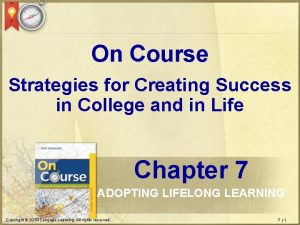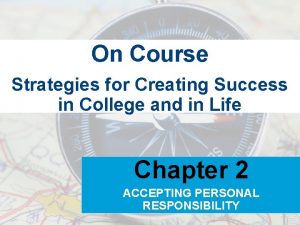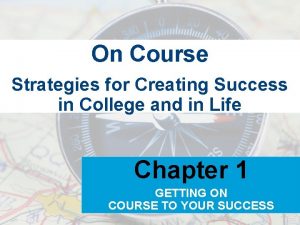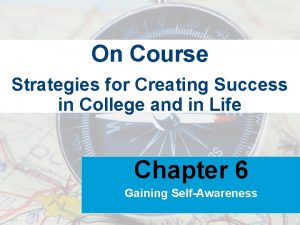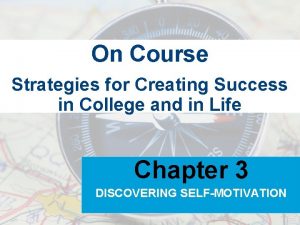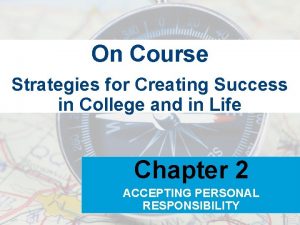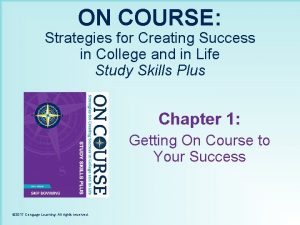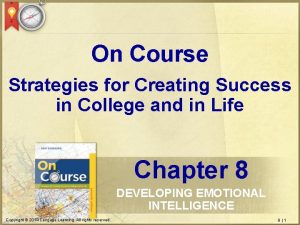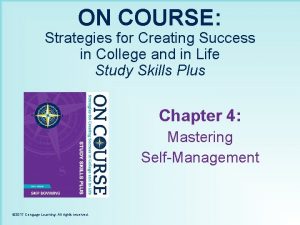On Course Strategies for Creating Success in College








































- Slides: 40

On Course Strategies for Creating Success in College and in Life Chapter 4 MASTERING SELF-MANAGEMENT Copyright © 2014 Cengage Learning. All rights reserved. 4|1

MASTERING SELF-MANAGEMENT • Are you on course to being successful and taking all of the actions necessary to achieve your desired outcomes and experiences? Ø Are you acting on purpose, making choices that keep you on course to your goals and dreams? Ø Are you employing self-management tools, regularly planning and carrying out purposeful actions? Ø Are you developing self-discipline, showing commitment, focus and persistence in pursuing your goals and dreams? Copyright © 2014 Cengage Learning. All rights reserved. 4|2

CRITICAL THINKING: FOCUS QUESTIONS ACTING ON PURPOSE • Have you ever noticed how much highly successful people accomplish? • How do they make such effective use of their time? llin Sergey Copyright © 2014 Cengage Learning. All rights reserved. 4|3

HARNESS THE POWER OF QUADRANT II • Imagine it is the first day of English class. You are assigned a ten-page essay due in ten weeks. Give an example of an action for each of the quadrants. URGENT Quadrant I Writing the entire paper the night before it is due IMPORTANT Quadrant III NOT IMPORTANT Letting friends talk you into going for pizza instead of proof reading your paper Copyright © 2014 Cengage Learning. All rights reserved. NOT URGENT Quadrant II Creating a ten-week plan to complete the essay step by step Quadrant IV Playing video games for 4 hours each night instead of writing and revising your essay 4|4

QUADRANT I ACTIONS IMPORTANT & URGENT • Get into groups of 4 and list choices that resulted in your later having to spend time in Quadrant I. Ø Example: I watched TV for 2 hours; then I had to stay up late to finish my math homework when I was exhausted. Ø Example: I put off going to the doctor for too long; then I had to go to the emergency room. • Share your experiences with the rest of the class. Ø What different choices could you have made? Copyright © 2014 Cengage Learning. All rights reserved. 4|5

QUADRANT II ACTIONS IMPORTANT & NOT URGENT • List Quadrant II actions that you do regularly to be a success in college. • Form groups of 4 and discuss your lists. • As a group, choose the 3 best Quadrant II actions for college students. • Share these strategies with the rest of the class. mkabakov Copyright © 2014 Cengage Learning. All rights reserved. 4|6

QUADRANT III NOT IMPORTANT & URGENT • Sit in a large circle with everyone facing the center. • Stand up, one at a time and give an example of when you chose to do something in Quadrant III (NOT IMPORTANT and URGENT). ØDo the responses have anything in common? ØIf so, what is the commonality? Copyright © 2014 Cengage Learning. All rights reserved. 4|7

QUADRANT IV NOT IMPORTANT & NOT URGENT • Sit in a large circle with everyone facing the center. • Stand up, one at a time and give an example of when you chose to do something in Quadrant IV (NOT IMPORTANT and NOT URGENT). ØDo the responses have anything in common? ØIf so, what is the commonality? Copyright © 2014 Cengage Learning. All rights reserved. 4|8

CRITICAL THINKING: FOCUS QUESTION CREATING A LEAK-PROOF SELF-MANAGEMENT SYSTEM • How can you devote more time to creating the outcomes and experiences that matter most to you? Elnur Copyright © 2014 Cengage Learning. All rights reserved. 4|9

TIME AND CULTURE • Determine if the following statements are True or False for you. ØHardly anyone in my family shows up on time for family gatherings. ØI often hear someone in my family talk about being late for work. ØIn college, I have been late for classes or appointments. • If you answered True for any of these statements, what are your cultural beliefs about time? Copyright © 2014 Cengage Learning. All rights reserved. 4 | 10

TIME AND CULTURE • What is the predominant belief about TIME in North American higher education? • If this belief clashes with a student’s own belief about time, what choices could he or she make to be successful in college? Copyright © 2014 Cengage Learning. All rights reserved. 4 | 11

TIME MANAGEMENT TOOLS What is the time-management tool being described: Monthly Ø A chronological list of important actions that can be done only at a particular time. Calendar Next Ø A list of important actions that need to be Action List done as soon as possible. Ø A list of important actions that need to be Tracking Forms done numerous times to achieve a goal. Ø A list of actions that you need other Waitingpeople to do before you can take action. For List Ø A system to organize a multi-step project. Project Folder Copyright © 2014 Cengage Learning. All rights reserved. 4 | 12

CRITICAL THINKING: FOCUS QUESTIONS DEVELOPING SELF-DISCIPLINE • Do you find yourself procrastinating, even on projects that mean a great deal to you? • How can you keep taking purposeful actions even when you don’t feel like it? Vepar 5 Copyright © 2014 Cengage Learning. All rights reserved. 4 | 13

DEVELOPING SELF-DISCIPLINE What are 3 inner qualities that would strengthen your self-discipline? ØCommitment ØFocus ØPersistence marekuliasz Copyright © 2014 Cengage Learning. All rights reserved. 4 | 14

STAYING FOCUSED • Answer the following questions about this school term as TRUE or FALSE. Ø I arrived late to class more than once. Ø I turned in an assignment that wasn’t my best work. Ø I daydreamed or side-talked during class. Ø I missed a class. Ø I thought about dropping a class and starting over. Ø I crammed for a test/quiz that was a major grade. • Get into groups of 4, discuss your answers, and brainstorm strategies for staying focused. Copyright © 2014 Cengage Learning. All rights reserved. 4 | 15

BEING PERSISTENT • Think of a behavior that would help you become more successful in school, one you could do every day. • Write that behavior at the top of a 32 -Day Commitment form. • For 32 days, place a check mark next to each day that you implement the behavior. • In 32 days, you will most likely have implemented the behavior as part of your daily routine! Copyright © 2014 Cengage Learning. All rights reserved. 4 | 16

SELF-MANAGEMENT AT WORK • Following are five Quadrant II actions you can take now to enhance your resume’. Ø Create a portfolio of your best college work. Ø Get an internship with a prospective employer. Ø Engage in volunteer opportunities. Ø Join clubs/activities that relate to your career. Ø Get involved with the Student Government at. your college. • Rank these five choice in order from the most to least impressive on your resume’. Copyright © 2014 Cengage Learning. All rights reserved. 4 | 17

CRITICAL THINKING: FOCUS QUESTIONS DEVELOP SELF-CONFIDENCE • In which life roles do you feel most confident? • In which do you experience self-doubt? • What can you do to increase your overall selfconfidence? Copyright © 2014 Cengage Learning. All rights reserved. 4 | 18

CELEBRATE YOUR SUCCESSES & TALENTS • • Take a few minutes to think about your successes. Write each success on an index card. Stack your cards into a “Success Deck. ” Over the following weeks, continue to write your successes on cards as they occur and add them to your deck. At the end of each day, read through and reflect on your “Success Deck. ” • When you have collected 20 success cards, treat yourself to something special! Copyright © 2014 Cengage Learning. All rights reserved. 4 | 19

VISUALIZE PURPOSEFUL ACTIONS • Why is it important to visualize purposeful actions? • Why is it important to use all 5 senses when you visualize? • What specific visualizations would support your success? Kiselev Andrey Valerevich Copyright © 2014 Cengage Learning. All rights reserved. 4 | 20

RECOMMENDATION LETTERS • Imagine that you have earned your highest desired degree and have applied for your dream job. • Your prospective employer asks for a reference letter from one of your college professors, so you ask one of your present instructors to write this letter for you. • Pretend you are that instructor and write an honest and thorough letter of recommendation based on your actual behaviors and attitudes this semester in his/her class. Of course give examples. Copyright © 2014 Cengage Learning. All rights reserved. 4 | 21

RECOMMENDATION LETTERS • You have 10 minutes to write your letter of recommendation. Do not put your name on it. I will collect and read them aloud anonymously. • As you listen to each letter of recommendation, decide if the applicant should: ØDefinitely get an interview ØPossibly get an interview ØNever get an interview • Explain your reasons for each decision and suggest any behaviors the applicant could improve to get a stronger recommendation. Copyright © 2014 Cengage Learning. All rights reserved. 4 | 22

QUICK REVIEW • Match each Quadrant with its description. Quadrant I ØUrgent & Not Important Quadrant II ØNot Urgent & Not Important Quadrant III ØUrgent & Important Quadrant IV ØNot Urgent & Important Copyright © 2014 Cengage Learning. All rights reserved. 4 | 23

QUICK REVIEW • What are 3 inner qualities that will help you develop strong Self-Discipline? Commitment Focus Persistence Copyright © 2014 Cengage Learning. All rights reserved. 4 | 24

QUICK REVIEW Identify each of the self-management tools: A chronological MONTHLYlist of important actions that can be CALENDAR done only at a particular time. A list of important actions NEXT ACTIONS that need. LIST to be done as soon as possible. A list of TRACKING important actions that need to be. FORM done numerous times to achieve a goal. A list of actions that you need WAITING-FOR other people. LIST to do before you can take action. Copyright © 2014 Cengage Learning. All rights reserved. A tool PROJECT to help organize a multi-step project. FOLDER 4 | 25

On Course Strategies for Creating Success in College and in Life Chapter 4 Wise Choices in College ORGANIZING STUDY MATERIALS Copyright © 2014 Cengage Learning. All rights reserved. 4 SS | 26

ORGANIZING STUDY MATERIALS: THE BIG PICTURE • Three key factors in developing deep and lasting learning are Prior Learning, Quality of Processing and Quantity of Processing. • Which of these three factors are we addressing most when Organizing Study Materials? Quality Of Processing Copyright © 2014 Cengage Learning. All rights reserved. 4 SS | 27

GENERAL STRATEGIES TO IMPROVE STUDYING • What are some good general study habits that you can use in learning any subject? ØEmploy prime learning times. ØTackle challenging subjects first. ØTake regular breaks. ØChange subjects periodically. ØAdopt a growth mind-set. Copyright © 2014 Cengage Learning. All rights reserved. 4 SS | 28

ORGANIZING STUDY MATERIALS • Form groups of 5. • Share with your group the way you presently organize your study materials (if you do) and why. • Be prepared to share your strategies with the class. Copyright © 2014 Cengage Learning. All rights reserved. 4 SS | 29

STRATEGIES TO IMPROVE LEARNING BEFORE ORGANIZING STUDY MATERIALS Imagine you are in your room about to study for a test in a difficult course. You are sitting on your bed re-reading your text book. The pillow you are leaning on keeps slipping down the headboard. The ceiling light keeps flickering, and your brother is playing a video game with the sound on loud in the room next door. Some of your class notes are in the kitchen; some are…well, you’re not sure where. Ø What wise choices could you make to get the most out of your study session? Copyright © 2014 Cengage Learning. All rights reserved. 4 SS | 30

STRATEGIES TO IMPROVE LEARNING WHILE ORGANIZING STUDY MATERIALS • Imagine you have marked annotated all of your reading assignments and have taken detailed notes in class. ØHow would you condense this information into effective study materials? ØWhen it is time to organize your condensed notes, which option would you prefer: a linear organizer or a graphic organizer? Why? Copyright © 2014 Cengage Learning. All rights reserved. 4 SS | 31

STRATEGIES TO IMPROVE LEARNING WHILE ORGANIZING STUDY MATERIALS Identify each of the following linear organizers: You copy the textbook’s table of contents onto a blank page. Then you add important information from your class notes. Outline You summarize all of the information from your textbook, class notes, handouts, etc. , into tightly focused paragraphs that each explains a key concept. Concept Blocks You write a question on one side of an index card and the answer on the other. After verifying the accuracy and appropriateness of the questions, you review them often. Copyright © 2014 Cengage Learning. All rights reserved. Flash Cards 4 SS | 32

STRATEGIES TO IMPROVE LEARNING WHILE ORGANIZING STUDY MATERIALS • What type of graphic organizer is this? Watercraft Aircraft Transportation Skied Railed Tr ac ke d Vehicles Wheeled • When would it be especially useful? Copyright © 2014 Cengage Learning. All rights reserved. Truc ks Cars Moto rcycl e 4 SS | 33

STRATEGIES TO IMPROVE LEARNING WHILE ORGANIZING STUDY MATERIALS • What type of graphic organizer is this? A Three-Column Study Chart for Math Problem Find an equation Solution Step 1: y=4 x+b Explanation Substitute 4 for the of the line with “m” in y=mx+b; slope 4 that “m” is the slope contains the points (2, -1) Step 2: -1=4(2)+b Replace “x” with 2 and “y” with -1 • In which courses would it be especially useful? Copyright © 2014 Cengage Learning. All rights reserved. 4 SS | 34

STRATEGIES TO IMPROVE LEARNING WHILE ORGANIZING STUDY MATERIALS Successful Students Struggling Students Act on purpose, choosing actions Wait passively or wander from one that move them on course to unpurposeful activity to another their goals and dreams Employ self-management tools, regularly planning and carrying out purposeful actions Live disorganized, unplanned lives, What type of information constantly responding to whims of the moment. would be useful to include in this Quit or change course when their comparison chart? actions don’t lead to immediate Develop self-discipline, showing commitment, focus, and persistence in pursing their goals success. and dreams. Copyright © 2014 Cengage Learning. All rights reserved. 4 SS | 35

STRATEGIES TO IMPROVE LEARNING WHILE ORGANIZING STUDY MATERIALS • What type of graphic organizer is this? A Cornell Study Sheet Abraham Maslow (1908 -1970) --Family immigrated to Brooklyn to Russia ---one of seven children What is the ---unhappy, neurotic child psychological --Taught at Teachers College, Brooklyn College, Brandeis movement that --Sought to understand human motives Maslow led? --Became leader of humanistic psychology movement of the 50’s and 60’s Abraham Maslow became the leader of the humanistic psychology movement in 1950’s and 1960’s. Unlike Freudian and behavioral psychologist, humanists believe people have the power to choose their own behaviors. Copyright © 2014 Cengage Learning. All rights reserved. 4 SS | 36

STRATEGIES TO IMPROVE LEARNING WHILE ORGANIZING STUDY MATERIALS Match the following graphic organizers to their correct description. Create diagrams and drawings Especially helpful in developing a deeper understanding of how items are alike and unalike. Comparison charts Especially helpful for auditory learners. Can pose questions to yourself, pause, and then offer the answer. Create an audio recording Especially helpful for understanding a subject that requires classification. Visually depicts the relationships among levels of information. Hierarchies Especially helpful for visual learners. An easy way to convert words into visual information. Copyright © 2014 Cengage Learning. All rights reserved. 4 SS | 37

STRATEGIES TO IMPROVE LEARNING AFTER ORGANIZING STUDY MATERIALS • After you organize your study materials, what are some successful strategies you could implement. ØRead more on the same subject and add the new information to your study materials. ØGet feedback on your study materials and ask for suggestions. ØIf there are concepts you still don’t understand, seek help (instructors, tutors, etc. ) to improve your study materials. Copyright © 2014 Cengage Learning. All rights reserved. 4 SS | 38

CREATING AN ACADEMIC SKILLS PLAN FOR ORGANIZING STUDY MATERIALS • Look over the strategies for Rehearsing and Memorizing Study Materials. • Choose three that you will implement immediately. • Explain to a partner the three that you have chosen and why. Africa Studio Copyright © 2014 Cengage Learning. All rights reserved. 4 SS | 39

End Chapter Four Copyright © 2014 Cengage Learning. All rights reserved. 4 | 40
 On course strategies for creating success in college
On course strategies for creating success in college Inner defender examples
Inner defender examples Your child's success or lack of success
Your child's success or lack of success Your child's success or lack of success
Your child's success or lack of success Peak performance success in college and beyond
Peak performance success in college and beyond High school gpa as predictor of college success
High school gpa as predictor of college success Erika mathis
Erika mathis Foster youth college success initiative
Foster youth college success initiative On course strategies
On course strategies One and a half brick wall
One and a half brick wall Course number and title
Course number and title Course interne moyenne externe
Course interne moyenne externe Active reading strategies college
Active reading strategies college College interview tips and strategies
College interview tips and strategies Formuö
Formuö Typiska novell drag
Typiska novell drag Tack för att ni lyssnade bild
Tack för att ni lyssnade bild Vad står k.r.å.k.a.n för
Vad står k.r.å.k.a.n för Varför kallas perioden 1918-1939 för mellankrigstiden
Varför kallas perioden 1918-1939 för mellankrigstiden En lathund för arbete med kontinuitetshantering
En lathund för arbete med kontinuitetshantering Kassaregister ideell förening
Kassaregister ideell förening Tidböcker
Tidböcker Sura för anatom
Sura för anatom Förklara densitet för barn
Förklara densitet för barn Datorkunskap för nybörjare
Datorkunskap för nybörjare Tack för att ni lyssnade bild
Tack för att ni lyssnade bild Tes debattartikel
Tes debattartikel För och nackdelar med firo
För och nackdelar med firo Nyckelkompetenser för livslångt lärande
Nyckelkompetenser för livslångt lärande Påbyggnader för flakfordon
Påbyggnader för flakfordon Kraft per area
Kraft per area Offentlig förvaltning
Offentlig förvaltning Jag har nigit för nymånens skära text
Jag har nigit för nymånens skära text Presentera för publik crossboss
Presentera för publik crossboss Vad är ett minoritetsspråk
Vad är ett minoritetsspråk Kanaans land
Kanaans land Klassificeringsstruktur för kommunala verksamheter
Klassificeringsstruktur för kommunala verksamheter Mjälthilus
Mjälthilus Bästa kameran för astrofoto
Bästa kameran för astrofoto Centrum för kunskap och säkerhet
Centrum för kunskap och säkerhet Byggprocessen steg för steg
Byggprocessen steg för steg
